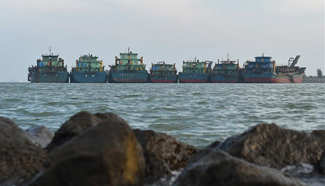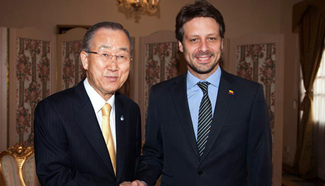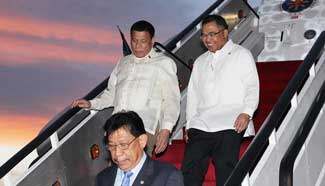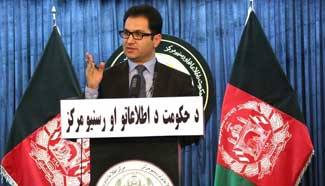II. Ensuring Impoverished People's Right to Life
It is one of the basic policies of the Chinese government to innovatively improve its methods in reducing and eradicating poverty, and takes targeted measures to that end. Recently, through data tracking on the conditions of the impoverished population, the government analyzes the causes of their problems, and offer guidance on their development needs. Targeted measures are implemented in terms of funding, projects, and recipients. Every impoverished household is guaranteed help, every village has designated officials to carry out poverty eradication measures, and goals are met within the defined standards. In the fight against poverty, China has enhanced poverty eradication effects, accelerated the speed of poverty eradication, and ensured impoverished people's right to life.
Support has been given to poverty eradication through developing industries with local features. The state has issued a series of development plans and policies regarding industries with local features to provide growth opportunities for impoverished areas. These include the Guiding Opinions on Strengthening Poverty Alleviation Work in the Agricultural Industry and Poverty Alleviation Plan in the Forestry Sector (2013-2020), which focuses on developing agriculture and animal husbandry with local features. Poverty Alleviation Through Development Plan of the Agricultural Industry (2011-2020); Measures for Increasing the Income of Industries with Local Features and Development Plan for Economic Forests (2013-2020), which lay out a good plan for the development of agriculture, forestry, and animal husbandry in contiguous poverty-stricken areas, with key areas specified; and Regional Layout of Agricultural Products with Local Features (2013-2020), which covers 96 agricultural products with local characteristics in impoverished areas for unified planning, with increased investment from various sources. During the Twelfth Five-Year Plan period (2011-2015), RMB122 billion was spent on agricultural infrastructure and specialized funds, and RMB116 billion on forestry infrastructure and specialized funds in contiguous poverty-stricken areas. Driven by the industries with local characteristics, poverty-stricken areas are seeing greater momentum in their development, with growing incomes for farmers.
Poverty alleviation through resettling impoverished population has been steadily carried out. Since 2012 the state has allocated RMB40.4 billion from the central government to leverage a total investment of RMB141.2 billion of all kinds, resettling 5.91 million impoverished people. The central and provincial coffers as well as local governments at various levels have provided RMB38 billion for poverty reduction, resettled 5.8 million poor people. These concerted efforts have effectively brought more development opportunities to poverty-stricken areas. Through scientific planning and careful site selection, infrastructure and community services have been strengthened in resettlement areas, significantly improving the living and working conditions of the relocated population. By developing farm production and animal farming, and guiding workers to travel to seek employment elsewhere, China has seen increases in the income of resettled farmers and migrant workers, with faster progress in eradicating poverty and achieving prosperity. In 2016 the Chinese government has initiated a new round of resettlement programs for its impoverished population, with increased funds from central government, and further raised subsidy standards. It has introduced policy-based funds for development, expanded funding sources, and strengthened follow-up support to relocated people, ensuring that each resettled household is lifted out of poverty.
Poverty eradication through ecological conservation is making progress. In poverty-stricken areas, the state promotes the protection of natural forest resources, returning farmlands to forests and grazing land to grasslands, controlling the sources of sandstorms affecting the Beijing- Tianjin area, controlling stony desertification, and protecting biological diversity. All these efforts have contributed to protecting the ecology in impoverished areas and restoring the environment, to improving local ecology, to providing more opportunities for the impoverished population, to boosting the industries with local characteristics, and to increasing the employment and income of local residents and protecting the resources required for their development. China has established a mechanism for ecological compensation, and is actively promoting the program in poverty-stricken areas. It has further raised the standards of compensating the ecological benefits of forests, improving the reward mechanism for grassland ecological protection, and promoting the modernization of animal husbandry in poverty-stricken areas. Measures have been taken to expand the income channels of the impoverished population, and to encourage voluntary work by those living in the key projects areas, thereby bringing them benefits. China strives to improve living conditions of impoverished population. Efforts have been made to improve the ecological environment of impoverished counties, and to promote the development of woody grain and oil, specialty fruits, timber and bamboo forests, forest-dependent industries, herbivorous animal husbandry, and eco-tourism, effectively improving the lives of the impoverished population.
Increased efforts have been made to alleviate poverty through education. During the Twelfth Five-Year Plan period, China prioritized education in its effort to eradicate poverty. The measures included: continuing to promote the balanced development of compulsory education, closing the gap in education between urban and rural areas, improving education infrastructure in impoverished areas, implementing the Action Plan for Three-Year Preschool Education, offering cost-of-living subsidies to teachers in rural areas, and enrolling students from poverty-stricken areas, exempting their tuition fees at secondary vocational schools, and allotting living subsidies to the students. All this was targeted at ensuring impoverished people's access to education.
In 2012-2015, the central government injected RMB83.1 billion into poor compulsory education schools, and RMB14 billion to build 244,000 dormitory units for 300,000 teachers in remote rural areas. The state carried out a three-year action plan to promote preschool education, increasing the nation's three-year preschool gross enrollment rate from 62.3 percent in 2011 to 75 percent in 2015. In central and western China, the number of children enrolled in kindergartens rose from 21.53 million in 2011 to 27.89 million in 2015, up 30 percent. Following the release of the Notice on Unifying the Establishment of the Faculty and Staff of Elementary and Secondary Schools in Urban and Rural Areas, issued in November 2014, the teaching and administrative staff of elementary and secondary schools in villages, counties, and towns began to enjoy the same standards of establishment as urban schools, with favorable treatment for those in remote poor rural areas. In 2013-2015, the central government allotted RMB4.4 billion for cost-of-living subsidies for rural teachers in contiguous poverty-stricken areas, benefiting over one million teachers in 600 counties. In 2012-2015, the central government provided RMB41.7 billion in tuition subsidies to secondary vocational schools, and granted exemptions from tuition fees to rural students (including those from counties and towns) and urban students with agriculture-related majors or with financial difficulties (except those majoring in arts) at full-time public secondary vocational schools. Students who were eligible for tuitions exemption at private secondary vocational schools certified by administrative organs were guaranteed the same tuition exemptions as students of the same major at local public secondary vocational schools. The state offers grants to first- and second-year students with agriculture- related majors or with financial difficulties at full-time schools, and the standard has been raised from RMB1,500 per student per year in 2012-2014 to RMB2,000 since the spring semester of 2015, covering 40 percent of students. A directional enrollment program was carried out in poverty-stricken areas, enrolling 183,000 students in 832 impoverished counties form 2012 to 2015. In 2013-2015, the annual growth rate of rural students from poor areas enrolled in key universities was kept above 10 percent.
Chart: Spending of the central government on poverty alleviation through education
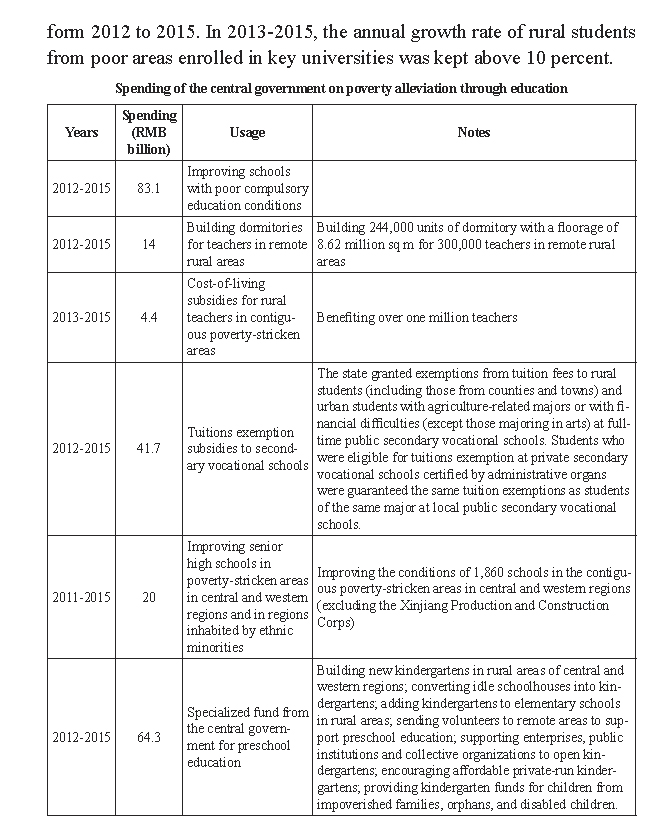
Graphics shows the spending of the central government on poverty alleviation through education, Oct. 17, 2016.(Xinhua/Zhou Daqing)
Poverty alleviation through medical security has been implemented. The Chinese government continues to strengthen its poverty alleviation effort through promoting medical security, reducing the medical costs of the impoverished population in rural areas, strengthening medical and health services in poverty-stricken areas, and improving the health of people in these areas, so that they are not reduced to or returned to poverty because of illness. All this has ensured the right to health. Improvement has been made in the New Rural Cooperative Medical System (NRCMS), which covers over 97 percent of rural residents. In 2016, the NRCMS offers a per capita subsidy of RMB420, and reimbursement ratios of outpatient and inpatient costs reached 50 percent and 75 percent. Serious illness insurance for urban and rural residents has been fully implemented, covering more than one billion residents with a reimbursement ratio of no lower than 50 percent. A medical emergency relief system has been established to help people suffering from serious illnesses, and universal medical care has been further improved to cover major illnesses, significantly reducing the medical costs of rural residents. Since 2012, the central government has allocated RMB79.4 billion to support infrastructure construction at 110,000 health service units in poverty-stricken areas. Programs have been carried out to offer free medical education to rural students who will return to serve in their areas, to send general practitioners to clinics in rural areas, to pair up hospitals in urban and rural areas to enable medical assistance, and to organize state-level hospitals to help and support county-level hospitals in poverty-stricken areas. In 2015, 45 items in the 12 categories of basic public health services were implemented, with per capita subsidy rising from RMB15 in 2011 to RMB40. Programs have been carried out to ensure that women in rural areas have access to folic acid supplements in order to prevent neural tube defects, and to improve child nutrition in poverty-stricken areas, in an effort to strengthen disease prevention and control and promote good health. Thanks to these efforts the health of the impoverished population has gradually improved. In 2016, the National Health and Family Planning Commission, the State Council Leading Group of Poverty Alleviation and Development, and 13 other departments jointly launched a poverty alleviation project through health promotion, so as to ensure that the impoverished rural population will welcome the arrival of a moderately prosperous society with the rest of the nation.
Chart: NRCMS per capita subsidy

Graphics shows NRCMS per capita subsidy, Oct. 17, 2016. (Xinhua/Zhou Daqing)
Programs are being implemented to lift all rural residents out of poverty. The state has released a plan to align the subsistence allowances system with development-oriented poverty alleviation policies in rural areas. Focusing on the goals of poverty eradication, all localities are improving their policies, measures, and working mechanisms to offer subsistence allowances to the most impoverished rural residents, striving to increase the standards of social security for the impoverished population. Registered rural families eligible for subsistence allowances are included in the subsistence allowance system in accordance with established procedures, and they receive the allowances based on the gap between their per capita household income and local subsistence allowance standards. Rural families covered by the subsistence allowances and eligible for poverty reduction programs are registered in accordance with established procedures, and receive help and support based on the different causes of their poverty. Families which were lifted out of poverty but have returned to poverty are included in temporary relief, medical relief, rural subsistence allowances and other social relief systems, and are registered for help and support. In 2015, the number of recipients of rural subsistence allowances was 49.04 million, with the standard raised from RMB143 per person per month in 2011 to RMB265. Per capita expenditure on supporting rural population in dire poverty in nursing homes and at their own homes reached RMB6,026 and RMB4,490, growing by 48.4 percent and 49.3 percent compared with the 2012 levels.
Experiments have been carried out on poverty alleviation through asset investments. In recent years, to help impoverished people experiencing difficulties in achieving self-development, some localities are actively experimenting on poverty alleviation through asset investments. With poverty reduction as the ultimate goal, poverty alleviation funds and other funds for rural areas are invested in infrastructure construction and industrial development in poverty-stricken areas, and the assets are quantified as shares owned by the households with a partial or permanent inability to increase their property income. The investment is mainly made by promising industries with local characteristics, and the farmers' specialized cooperatives often play an active role in running the operations, to ensure that impoverished people enjoy a guaranteed return and dividends on such asset investments, and that they may also benefit from transferring their farmlands and working in local businesses. At the end of 2014, the state initiated trial runs of poverty alleviation projects through developing the photovoltaic industry in provinces of Anhui, Hebei, Shanxi, Gansu, Qinghai, and Ningxia Hui Autonomous Region, pumping new blood into these regions by increasing their asset income. In 2016, the state has strengthened the initiative, planning to increase the average household income of two million households registered with incapacity (including disabled persons) to RMB3,000 and above by 2020. This will involve 35,000 registered villages in 471 counties of 16 provinces and autonomous regions.
Services have been strengthened to support employment and entrepreneurship. In recent years, the government has given top priority to employment, enacting more active employment policies, providing vocational training, and strengthening services to support employment and entrepreneurship, effectively ensuring impoverished people's right to work. It has launched the Spring Tide Action, a program to enhance the occupational skills of migrant workers, providing impoverished rural laborers with training programs in employment and occupational skills, and starting businesses, with subsidies provided for attending these trainings. The state has implemented the Opinions on Strengthening the Dewdrop Project to Support New Laborers from Impoverished Rural Families to Receive Vocational Training, providing an annual subsidy to registered impoverished families with people receiving vocational education. China has further improved its public services for employment. It has strengthened the platform for labor and employment and social security services at the grassroots level, organized the Spring Breeze Action and other employment services, strengthened the alignment of labor exports and imports, and offered free services to the impoverished rural population in guiding their employment choices, introducing jobs and opportunities, and offering counseling on the policies, laws, and regulations regarding employment. The state has helped surplus rural laborers to seek employment in cities and promoted their steady transfer, with 7.93 million new migrant workers added on a yearly basis in 2011- 2014. China has actively implemented policies to support entrepreneurship, organizing training sessions for people who are interested in starting businesses and who need training in entrepreneurship and relevant services. Other services such as information, guidance on business operations, new business incubation, and follow-up services are also provided to support new entrepreneurs.




